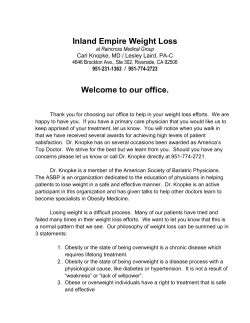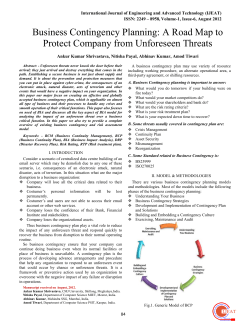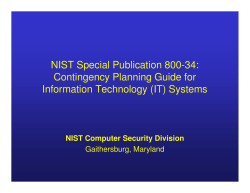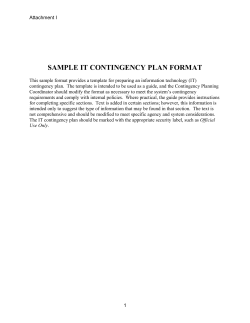
Contingency Planning: Addressing Critical Business Processes That Support Implementation of
Contingency Planning: Addressing Critical Business Processes That Support Implementation of HIPAA Transactions Marie Margiottiello, CMS Henry Chao, CMS February 12, 2003 New Orleans Overview � � � Definitions Risk Analysis Analyzing Risk Relative to HIPAA Impact � � � � � � � � � Identification of Critical Business Processes Identification of Potential Failures Business Impact Analysis Minimum Acceptable Levels Identification of Alternatives/Contingency Develop The COOP Testing Training & Updating the Plan Examples Definitions �DISASTER RECOVERY PLAN: The document that defines the resources, actions, tasks and data required to manage the business recovery process in the event of a business interruption. The plan is designed to assist in restoring the business process within the stated disaster recovery goals. Source: Disaster Recovery Journal Definitions �CONTINGENCY PLAN: A plan used by an organization or business unit to respond to a specific systems failure or disruption of operations. A contingency plan may use any number of resources including workaround procedures, an alternate work area, a reciprocal agreement, or replacement resources. Source: Disaster Recovery Journal Definitions �DISASTER RECOVERY PLANNING: The technological aspect of business continuity planning. The advance planning and preparations that are necessary to minimize loss and ensure continuity of the critical business functions of an organization in the event of disaster. SIMILAR TERMS: Contingency Planning; Business Resumption Planning; Corporate Contingency Planning; Business Interruption Planning; Disaster Preparedness. Source: Disaster Recovery Journal Definitions �CONTINGENCY PLANNING: Process of developing advance arrangements and procedures that enable an organization to respond to an event that could occur by chance or unforeseen circumstances. Source: Disaster Recovery Journal Definitions � CONTINUITY OF OPERATIONS PLAN (COOP): A COOP provides guidance on the system restoration for emergencies, disasters, mobilization, and for maintaining a state of readiness to provide the necessary level of information processing support commensurate with the mission requirements/priorities identified by the respective functional proponent. This term traditionally is used by the Federal Government and its supporting agencies to describe activities otherwise known as Disaster Recovery, Business Continuity, Business Resumption, or Contingency Planning. Source: Disaster Recovery Journal Definitions � � � � For consistency, use Continuity Of Operations Plan (COOP) COOP can be inclusive of all activities associated with previous terms Organizational readiness begins with clear recognition, understanding, and commitment to the scope of your COOP You get what you pay for Risk Analysis �How � likely is it to occur ? ~ and ~ What impact would it have ? Risk Analysis � Specify probability and criticality � Product of: (probability) x (criticality) � Probability: chance that the future event will occur (if present, it’s a problem, not a risk) � Criticality: the impact of a future event (no impact = no risk) Risk Analysis � Degrees of probability � High – nearly certain (80 – 99%) � Moderate – probable, possible (20 – 80%) � Low – improbable (< 20%) � More ranges may be appropriate Risk Analysis � Degrees of Criticality � High – total failure or serious degrading of business function � Moderate – impaired performance � Low – little impact, but more than none � More ranges may be appropriate Analyze Risk Relative to HIPAA �Use accurate stats for your operations �Number of beneficiaries �Number of providers �Volume of transactions (by provider type, if possible) �$ value of transactions �MCOs �Helpline/Hotline call volume �Payment cycles �Waiver programs �Contractors’ roles �Are there state-level coordination issues? Identification of Critical Business Processes � Identify events with potential to degrade ability to do business � � � � � � Eligibility - Inquiry & Response Beneficiary Enrollment / Disenrollment Authorization – Request & Response Claim / Encounter Remittance / Payment Claims Status - Inquiry & Response Identification of Potential Failures Describe expected outcome of each event: � Eligibility � Inquiry not possible (receipt, validation, processing) � Response not possible (generation, translation, transmission) � Enrollment / Disenrollment � Enrollment not possible (generation, translation, transmission) � Disenrollment not possible ( generation, translation, transmission) � Authorization � Request not possible (receipt, validation, processing) � Response not possible (generation, translation, transmission) Identification of Potential Failures � Claim � Claim receipt not possible (receipt, translation) � Claim processing not possible (validation, adjudication) � Remittance / Payment � � RA not possible (generation, translation, transmission) Claim Status � Status inquiry not possible ( receipt, validation, processing ) � Status response not possible ( generation, translation, transmission) Identification of Potential Failures � Identify users and areas likely and seriously affected � � � � � � System areas modified but not tested thoroughly System areas tested only internally (not tested via actual B-2-B) Areas of end-user unfamiliarity (new processes, new outputs, new interfaces) Trading partner issues (process, product) Multiple degradations/failures, source of problem not easily determined Trickle down effect, identify other business associates affected Business Impact Analysis � Identify business process affected � Determine tolerance level if function(s) are degraded, disrupted, or completely unavailable Business Impact Analysis � Analyze process and ask “how BAD is it (really), if:” � Providers can’t determine if patients are eligible, � � � � � � or what they’re eligible for ? Recipients can’t get enrolled into a health plan ? Medical services can’t be authorized ? Claims aren’t received electronically ? Claims can’t be processed ? (validated, adjudicated, rejected, archived, etc.) Providers can’t be paid ? Providers can’t tell what the status of a claim is ? What Is The Tolerance? � Determine risk actions to be taken based on varying levels of tolerances for critical processes � Accept risk (do nothing) � Watch it (monitor) � Mitigate (reduce criticality and/or probability) � Plan for contingencies Business Impact Analysis � Document risk analysis (description and rationale) � Prioritized listing of critical business processes � Business processes should be identified, evaluated, and then ranked in order of importance Business Impact Analysis Dependency Dep #1 Dep #2 Dep #3 Probability Business Process: Duration Criticality Impact Total Risk Score Business processes BP #1 BP #2 BP #3 And so on Total score What’s the adverse impact on providers What’s the adverse impact on beneficiaries Political sensitivity % of monthly transactions % costs of this business process compared with total enterprise # of providers impacted # of beneficiaries impacted Business Impact Analysis Minimum Acceptable Levels � Eligibility – inquiries & responses � Enrollments & Disenrollments � Authorization – requests & responses � Claims – receipt & adjudication of EDI and paper � Remittance � Claims Status – inquiries & responses Identification of Alternatives Selection of Contingency � For each critical business process, identify all the possible alternatives (workarounds) � Select ONE alternative for each business process / scenario Develop The COOP � Each � � � � � � � contingency needs to specify: Assumptions Triggers Notification Resource Assignments Procedures Duration Monitoring (baseline parameters for planning) (indication of failure) (who to tell) ERT (who does what) (the work-around) (for how long) (see how it goes) Develop The COOP � Analyze and document required resources to support the plan � Establish command, communication, and control procedures for executing the plan; Includes: � Timely recognition of trigger of disruption � Designated plan invoker � Organized, responsive, and accessible emergency response team (ERT) Develop The COOP � Does your Incident Reporting mechanism work like this: …or slightly faster… � Require tested and operational Incident Reporting mechanism to support all communication channels Develop The COOP � � � Minimum Acceptable Level of Service: This is some predetermined level of service. It may be a percent of volume or length of time, etc. Triggers: These are the specific failure points that cause a COOP to be invoked. Events may be separated from triggers by a period of time before the contingency is invoked Concept of Operations: The concept of operations is a short summary paragraph providing a macro level view of how the workaround will unfold Develop The COOP � Emergency Response Teams � ERTs are tailored for each business process � The information should include positions, names of “who” is assigned, function, and telephone numbers [work, home, cell, pager], etc. � Contact procedures for ERT members: This section should indicate “what” method will be used to contact the ERT members: e.g. phone trees with home/cell/work numbers, ‘code’ announcements for state employees, email, other alternate means Develop The COOP � � � Escalation of Problems and Reporting Procedures: This is the information that is conveyed in the execution of the COOPs…verbal, written, frequency Training Plan: This section explains the “why” training is conducted, “when” it will be done, “who” conducts and receives training, and “how”. (Prep for doing the CPs, periodic, and just-in-time.) Validation Plan: This section describes a process for testing and validating the COOP. Develop The COOP � � � � Outreach Plan: This section explains “how” and “when” the Medicaid enterprise will communicate to beneficiaries and providers that contingency operations have started and ended Plan Maintenance Procedures: This section describes “how” the COOP will be reviewed, changed, updated and “who”is responsible Day One Strategy: Procedures for the initial transition to the COOP Distribution: This section lists “who” and “where” copies of the COOP are located Develop The COOP � � Disaster Recovery Plan: This section may be where a copy of the DRP (May be your F/A) is located for reference (IT and infrastructure) Alternative Strategies: This section provides for the identification of all possible workarounds from which one is selected (with justification) Example: Provider Claims � � � � hold all claims until system is recovered pay percentage of historical (previous month, quarter, year) pay prioritized list of providers most significantly impacted if not paid first in – first out Develop The COOP � � � Business partners affected: This section should identify all the business partners / other agencies affected by the implementation of the COOP -- “who” Resources and cost estimates to implement the COOP: This is a list of those things necessary to execute the COOP -- “what” Restore to normal ops: This section contains procedures for transitioning back to normal operations after a contingency is no longer required COOP Organization Public Relations Crisis Coordination Governor CMS Media Enterprise Management Team (XMT) Beneficiaries Providers Emergency Management Team (EMT) Contractors Other State Agencies Other Federal Agencies Emergency Response Team (ERT) Financial Institutions Other Stakeholders COOP Testing � Exercise COOP to ensure: � Adequacy of assumptions � Staff comprehension of COOP procedures � Under duress, staff can accomplish in expected timeframes, produce expected outcomes (for example, MALS) � Assigned COOP resources (alternate site, equipment, lines, ERT, etc.) are functional, available Training � Raise Awareness � Periodic presentations to team members, management, new employees � Offer external COOP training, conference opportunities, create library of publications � Conduct Validation Exercises � Desktop walk-thru or more realistic simulation “fire drill” � Pre-exercise brief, audit the process, document progress, allow participant feedback, and debrief � � Establish change control procedures Establish uniform distribution of plan; version control Updating the COOP � As personnel change � As situations change � Cycle of continuous improvement Training Revising Testing Table of Contents From Actual State BCCP/COOP Plan � � � � � � � � � � � � I. II. III. Introduction – Current Business Process Overview Assumptions Concept of Contingency Operations � a. Responsibilities – Rapid Response Organization: – i. Executive Team – ii. Operating Team – iii. Business Contingency Plan Managers � b. Incident Management Guide � c. Phone Trees IV. Eligibility Verification V. Claims Processing/Reimbursement Services VI. Systems Management VII. General Administration VIII. Managed Care IX. Chronic Care X. Acute Care XI. Legal and Regulatory XII. [Fiscal Agent] Disaster Recovery Plan CMS Central Office Response Process for State-Level Disaster/Disruption-Page 1 Notification may come from a variety of sources including, but not limited to: CMS Senior Staff CMS Regional Office(s) Press Office Public Media Disaster Event Affecting StateLevel Medicaid Operations ERT Leader should be made aully aware of the situation 018D indicates the use of a "Plan Invoker"--This is either a senior-level manager or a RMS designated contact Start Event Log Entries Disruption to State Payment and Eligibility Function Decide if disruption affects RO's ability to operate normally No Is the RO Affected? Yes Verify with Respective RO Staff (Preferably the RA or ARA) Go to Page 4 Yes RO Request copy of BCCP Forward to 018D ERT Leader SMA Invoked Contingency Plan? It is possible that the SMA invoked a systems disaster recovery plan rather than a business continuity plan- which is much more comprehensive. Determine the kind of plan invoked and compare the appropriateness of the response versus the disruption. No RO Contact SMA Staff to Asess Intention to Invoke BCCP Notify ERT Alternate and/or Co-Leader Begin Assessment of Impact to State Functions Page 4 lists the steps required to address disruption to the RO from the perspective of the CO. Each RO may invoke individual procedures, i.e., shift operations to another RO Communicate SMA Intention to ERT Leader ERT Leader or Designee No response required Exit point will be determined by the ERT Leader. Although no formal emergency response is required, ERT leader may designate a monitoring function prior to a complete exit. Decide Initial Response Procedure Only need subset of ERT Estimate impact requires significant resources Notify Select Members of ERT Notify all ERT Members Go to Page 2 Go to Page 2 Y/N Date or Expected Date Professional Claim/ Encounter [837P] Inpatient Claim/ Encounter [837I] Dental Claim/ Encounter [837D] Pharmacy Claim/ Encounter [NCPDP] Claim Receipt and Translation Claim Adjudication/Pricing/Calculation Capitation Payment Managed Care Administration Fee Payment Institutional LTC Payment Premium Payment [820] Medicare Buy-in Premium Payment Private Health Insurance Premium Payment Non-Standard Claim Payment Mass Claim Adjustment Transaction Claim, Encounter, and Payment Communications Remittance Advice [835] Claims Payment Check/Warrant Processing Claim Status Request, Voice/Fax/Electronic Claim Status Response [277] Claim Status Response, Voice/Fax/Electronic Eligibility Verification Request [270] Processing Request, Voice/Fax/Electronic Eligibility Verification Response [271] Processing Response, Voice/Fax/Electronic Eligibility and Enrollment Notices and ID Documents Recipient Maintenance, Communication/TPL/Appeals/Lock-in Eligibility Data Exchange Enrollment Transaction [834] Enrollment Rosters to MCO Request for Auth. of Service [278] Response for Auth. of Service [278] Prior Authorization Receipt, Voice/Fax/Paper/Electronic Messages, Receipt/Acknowledge/Accept/Reject Y/N Date or Expected Date Y/N Start Date of End-ToEnd Testing for HIPAA Transaction Date or Expected Date Date or Expected Date HIPAA Transaction with Associated Supporting Business and System Functions Implemented Y/N Start Date of Implementa tion of HIPAA Transaction Date or Expected Date Date or Expected Date Continuity of Operations COOP Updated for HIPAA Transaction Y/N Completed as of HIPAA Transaction with Associated Supporting Business and System Functions Tested Endto-End Implementation and Transition Completed as of HIPAA Transaction and supporting system functions renovated Testing Completed as of HIPAA Transaction and supporting business process assessed for HIPAA impact Renovation Completed as of For each phase from Gap Analysis through COOP, fill in the corresponding cells for each HIPAA transaction. Italicized, indented business processes are listed as prompters to ensure these have been addressed in each phase of HIPAA implementation. The list serves as a guideline and is not an exhaustive list of processes that is necessary to be addressed for HIPAA implementation. Completed as of Gap Analysis Date or Expected Date Unable to Meet 10/16/2003 Deadline for HIPAA Transaction, Prioritze for COOP Indicate Priority The following business processes are from Medicaid Administration and Utilization Management areas, which are impacted in varying degrees by some or all of the HIPAA transactions and would have to be addressed in all phases of HIPAA implementation from Gap Analysis through Continuity of Operations Planning. Utilization Review Review, Medical/Peer/Administrative Generate and Distribute EOMBs Catastrophic Case Management SURS – Establish System Parameters SUR Case Referrals for Investigation Provider Prepayment Review Retro DUR Fraud Detection Processing, Data Mining Quality Assurance, Medicaid/MCO/Enrollment Broker Rate Setting Rate Setting, Fee For Service/Managed Care/Co-Payment/Capitation Rates/Waiver Rates Rate Calculation, Institutional/Outpatient/Pharmacy/Clinic/Encounter/Non-Institutional Practitioner DME and Supplies Rates and Clinical Lab Fee Schedule Fees, Case Management/Administration Management Reporting Reporting, EPSDT/MSIS/HEDIS Decision Support Claims History Inquiry 1099 Production Public Health and Vital Statistics Reporting Financial Management Accounts Receivable/Payable/TPL Collection/Drug Rebate/Recoveries/Bank Reconcilliation Drug Rebate Drug Rebate Claim Selection Drug Rebate Invoicing Drug Manufacturer Response Processing Auditing Pharmacy Fill Fee Audit Cost Settlement Audits Quality Control Medicaid Eligibility Quality Control Claims Processing Quality Audits Translator Administration Translator Contract Management Mapping to Adjudication System Translator Maintenance Trading Partner Administration Data Exchange Information Acquisition Data Exchange Information Maintenance
© Copyright 2025





















